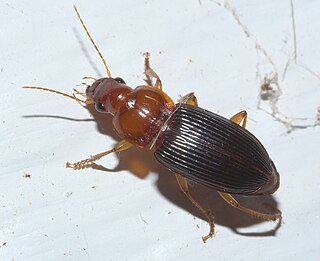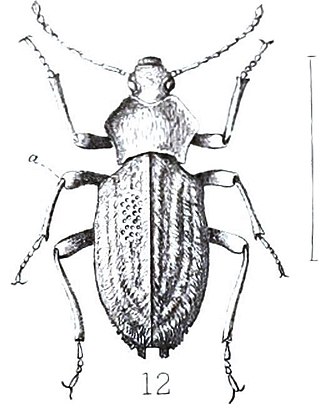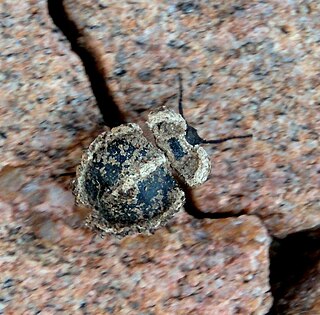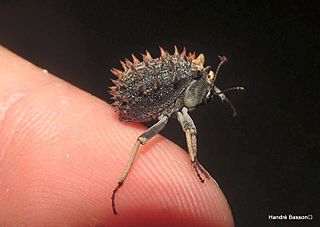
Darkling beetle is the common name for members of the beetle family Tenebrionidae, comprising over 20,000 species in a cosmopolitan distribution.

Eleodes is a genus of darkling beetles, in the family Tenebrionidae. They are endemic to western North America ranging from southern Canada to central Mexico with many species found along the Mexico-United States border. Some species have been introduced to Colombia. The name pinacate is Mexican Spanish, derived from the Nahuatl (Aztec) name for the insect, pinacatl, which translates as "black beetle".
Trachelostenus is a genus of darkling beetles in the family Tenebrionidae. It is native to the Valdivian forests of Chile, and has at least two species, T. inaequalis (Solier) and T. fascicularis (Philipp). It was historically considered the only member of the family Trachelostenidae, but a 2015 study sunk the genus into the tenebrionid subfamily Tenebrioninae.

Acupalpus is a genus of insect-eating beetle species. Its representatives are found across Europe, Asia, and North America.

Epicauta is a genus of beetles in the blister beetle family, Meloidae. The genus was first scientifically described in 1834 by Pierre François Marie Auguste Dejean. Epicauta is distributed nearly worldwide, with species native to all continents except Australia and Antarctica. Surveys have found the genus to be particularly diverse in northern Arizona in the United States. Few species occur in the Arctic, with none farther north than the southern edge of the Northwest Territories, Canada.

The Sepidiini is a tribe of ground-dwelling darkling beetles (Tenebrionidae), that occurs across Africa, the Mediterranean Basin, the Arabian Peninsula and Mesopotamia. It is composed of many hundreds of species. The larvae of some species are known to damage crops.

The tar darkling beetles (Somaticus) are an Afrotropical genus of darkling beetles (Tenebrionidae). Adults are omnivorous scavengers, and the larvae, known as false wireworms, feed on plant roots. The larvae of several species are known to damage maize crops. The adults are matte black with longitudinal ridges on the pronotum and elytra, and may be covered in hairs of different colours.

Sepidium is a genus of beetles of the family Tenebrionidae. It is the type genus of its tribe, Sepidiini.

The helmet toktokkies are ground-dwelling, Afrotropical beetles in the family Tenebrionidae.

Renatiella is a genus of diurnal, herbivorous beetles, which is found from East to southern Africa.

Harpalini is a tribe of a diverse group of ground beetles belonging to the subfamily Harpalinae within the broader family Carabidae. The tribe contains more than 1,900 species.

Asidini is a tribe of darkling beetles in the subfamily Pimeliinae of the family Tenebrionidae. There are more than 30 genera in Asidini.

Stenochiinae is a subfamily of darkling beetles in the family Tenebrionidae. There are more than 390 genera in Stenochiinae.

Hypomelina is a subtribe of darkling beetles in the family Tenebrionidae. There are about 9 genera and more than 40 described species in Hypomelina, found mainly in southern Africa. The majority of species were described from the Namibian coast, and only the genus Bombocnodulus is found as far north as central Africa.

Molurina is a subtribe of darkling beetles in the family Tenebrionidae. There are 28 genera and 579 described species and subspecies in subtribe Molurina. The type genus for this subtribe is Moluris. These beetles are widely distributed through the Afrotropics, with the exception of western Africa.

Adelostomini is a tribe of darkling beetles in the subfamily Pimeliinae of the family Tenebrionidae. There are more than 30 genera in Adelostomini, found primarily in tropical Africa.

Cryptochilini is a tribe of darkling beetles in the subfamily Pimeliinae of the family Tenebrionidae. There are about 11 genera in Cryptochilini, found in tropical Africa.

Tentyriini is a tribe of darkling beetles in the subfamily Pimeliinae of the family Tenebrionidae. There are more than 90 genera in Tentyriini.

Mariazofia is a genus of ground-dwelling Afrotropical beetles in the family Tenebrionidae. They are among the largest of the darkling beetles. Like other genera within subtribe Molurina, adults of this genus engage in a behavior known as "substrate tapping", a form of sexual communication in which they produce vibrations by tapping their abdomen rhythmically on the ground to attract mates. Their common name, "tok-tok beetle" or "toktokkie beetle", is based on this behavior.

















